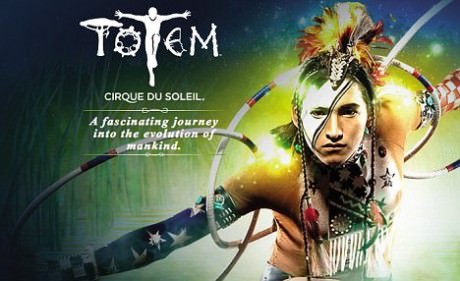Please introduce yourself and tell me when you were first approached by Cirque du Soleil to appear in TOTEM.

Cirque du Soleil was looking for a traditional hoop dancer to join the cast of TOTEM and they contacted the Heard Museum in Phoenix, AZ where I used to compete to get recommendations of dancers. The Museum gave them my contact information. After watching a video of my performance on YouTube, a Cirque casting scout called me and offered me a contract for the show. They gave me two weeks to think about it as it was a surprise and I never thought about leaving home and going on tour with Cirque du Soleil. This was in November 2011; I was completing a major in sociology and had to determine if I was ready to put my life aside for a moment. I decided to jump in. So, on January 1, 2012, I left Los Angeles and landed in Montreal, Canada to start rehearsing for the act and the character. I joined the show on tour in San Jose, CA in March, 2012.
‘Evolution’ is one of the main themes of TOTEM. How is ‘evolution’ reflected in your act?
The Hoop Dance reflects how humans relate to plants and animals; how nature is important in who we are and in our daily life. The different shapes I create with the hoops represent the different steps of the growth of an eagle. The act shows how man and eagle are connected to each other and help each other. In the final trick of the dance, I create wings with the hoops. As well as being the last step of the eagle’s growth, the wings represent the desire of man of always pushing further his limits to his ultimate desire to fly. That is why Robert Lepage, the director of TOTEM, wanted to integrate the Hoop Dance in the show, as is reflects the evolution that each human being goes through as well as the evolution of the human civilization. At the end of my second act, I create a globe with the 5 hoops that represent the World – how it all comes together.
The hoop itself represents eternity (the circle). The Hoop Dance is performed in traditional Wedding Ceremonies for that reason.
When were you first introduced to the ‘hoops’ and what was it about the hoops that made you want to perform with hem? What are the hoops made of?
I got interested in the hoops dance at 10 years old. I come from LA and never lived on a reservation, so I got interested in learning more about my ancestors’ culture (Lumbee tribe). I started attending Native American Events and quickly participated in competitions.
The hoop was originally made out of wood, but the ones I use are in plastic piping covered with electric tape. There are four colored parts on each hoop that represent the 4 directions (North, South, West, East).
How did you learn how to perform with the hoops and perform your act in TOTEM?
There are various styles of the Hoop Dance. Before joining TOTEM, I used to perform with 14 hoops. My routine was about 9 minutes long and was mostly static on one spot. The original Hoop Dancers of TOTEM were performing with 5 hoops, so I had to learn that technique to join the show. The two acts I perform (one solo and one duet with Shandien Larance, a female Hopi Hoop Dancer) are fast-paced (about 3.5 minutes long) and are not static at all; I have to move all around the stage which is definitely more demanding physically. I love this style; it is more dynamic and requires more agility, more skills and great conditioning. I trained for a little over two months at the Cirque du Soleil Headquarters to learn the routines before integrating the show. There is also another dimension in performing in TOTEM that I wasn’t exploring before. The act is not only about the technique and the skills; I also have to be a character and connect with the crowd, which was a challenge at first.

How has the act evolved since you first performed it in TOTEM?
I have been in the show for more than 5 months and have performed more than 150 times now and I can say the act is a lot tighter. I got used to the routines so it is physically easier and I am less tired at the end. I also feel I connect more with the public and get a stronger feedback from the crowd. It is definitely more solid! I feel the skills have become more natural so I can now really give my heart. I think I am doing the act with more intention and I am more aware of the artistic aspect of it and getting into the character.
There is chanting when you are performing with the hoops. What is being chanted?
Our lead singer, Christian Laveau, comes from a Canadian tribe called Huron-Wendat. He sings in his native language and in the style of his ancestors. He makes sounds to accentuate my movements and adds emotions to the overall scene.
You create many things with the hoops in the show. What is the most difficult thing to create and which is your favorite?
Most difficult: The Globe (Earth) that I create with the 5 hoops at the end of the duet is complicated as I have to go through it while maintaining its shape.
Favorite: The Eagle (wings) as it is the final trick of the solo act. I am dancing around the stage with the hoops like if I was saying: “Look What I Did, That’s what I was trying to be, This is who I am.”
Your costume represents many different tribes. What tribes are represented in the costume, and what parts of the costume represent the individual tribes?
My costume doesn’t represent a tribe in particular. It was designed to represent all American first nations without representing one in particular. It is like a standard of first nation.
Which act that is not your own still thrills you the most when you perform in TOTEM?
It is a difficult choice but I love the Russian Bars act, which is the final act of the show. I tried once to stand on the bar and I couldn’t find my balance at all. I can’t believe they are jumping from and landing on that tiny bar while doing amazing summersaults in the air. I love the act for its difficulty, but I am also inspired by the artists who perform it as they are hard workers and they are perfect. I also like the ambiance of the act and the fact it takes place in space.
What do you want Cirque audiences to learn or appreciate when they see you perform with your hoops?
I am happy I can share a part of the Native American culture with them and make them discover a new discipline they have probably never seen before (the Hoop Dance). Also, I want them to have a positive image of the first nations, to see that we are out there, that we can be successful and are beautiful people. I also want to share with them to story of the growth of the eagle, although everybody can have a different interpretation of the story of our dance.
What do you like most performing on the road and what are some of the challenges being on the road? How many cities have you been to with Totem and which cities and audiences have been your favorites?
I love being able to travel around the US and share my culture with thousands of people every day. The only challenge is that we sometimes feel far from our family. So far, I have toured with TOTEM in San Jose (CA), San Diego (CA) and Boston (MA). I loved the Boston audiences as they are loud and they have an interest for artistry.
Why should families come and see TOTEM when it comes to Washington, DC?
TOTEM is a joyful, colorful, positive and fun show for everyone; the kids will enjoy it and the adults will be completely blown away by the skills of the performers, but also by the overall artistry. Each act in the show has its own setting, so for 2.5 hours, the audience is traveling from one part of the world to the next, from one culture to the next. You completely escape from your life and let yourself be transported to the world of TOTEM. It is not just a show, it’s an experience!
Cirque du Soleil returns to Washington with TOTEM from August 15 – September 30, 2012 under the blue and yellow Big Top at the Plateau at National Harbor. Purchase tickets here.
LINK
TOTEM website.
https://www.youtube.com/watch?v=TsOzYup2_3Y






Toten was amazing, you guys are back to the quality of the first shows!!!!!!!
In love with the Indian routine…… The music ……. Incredible!!!!!!
Made my birthday very special!!!!!